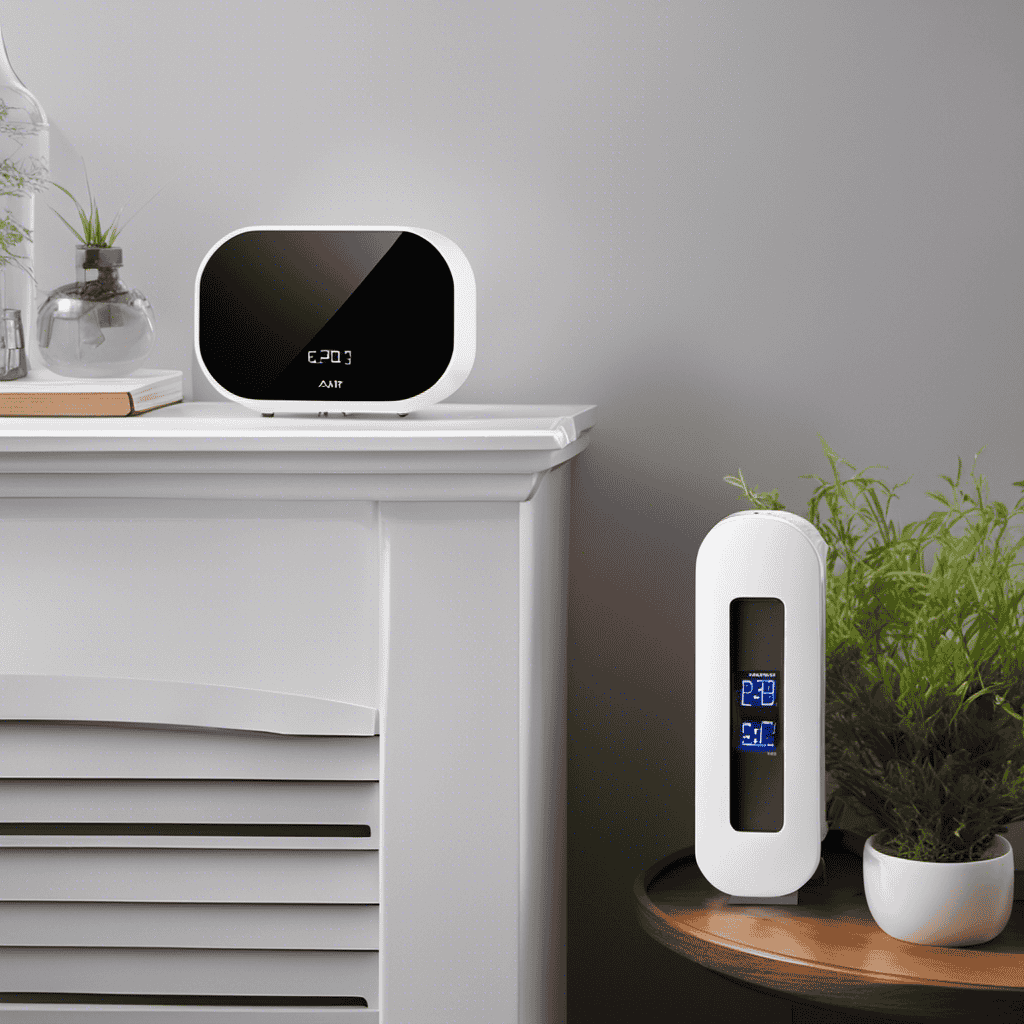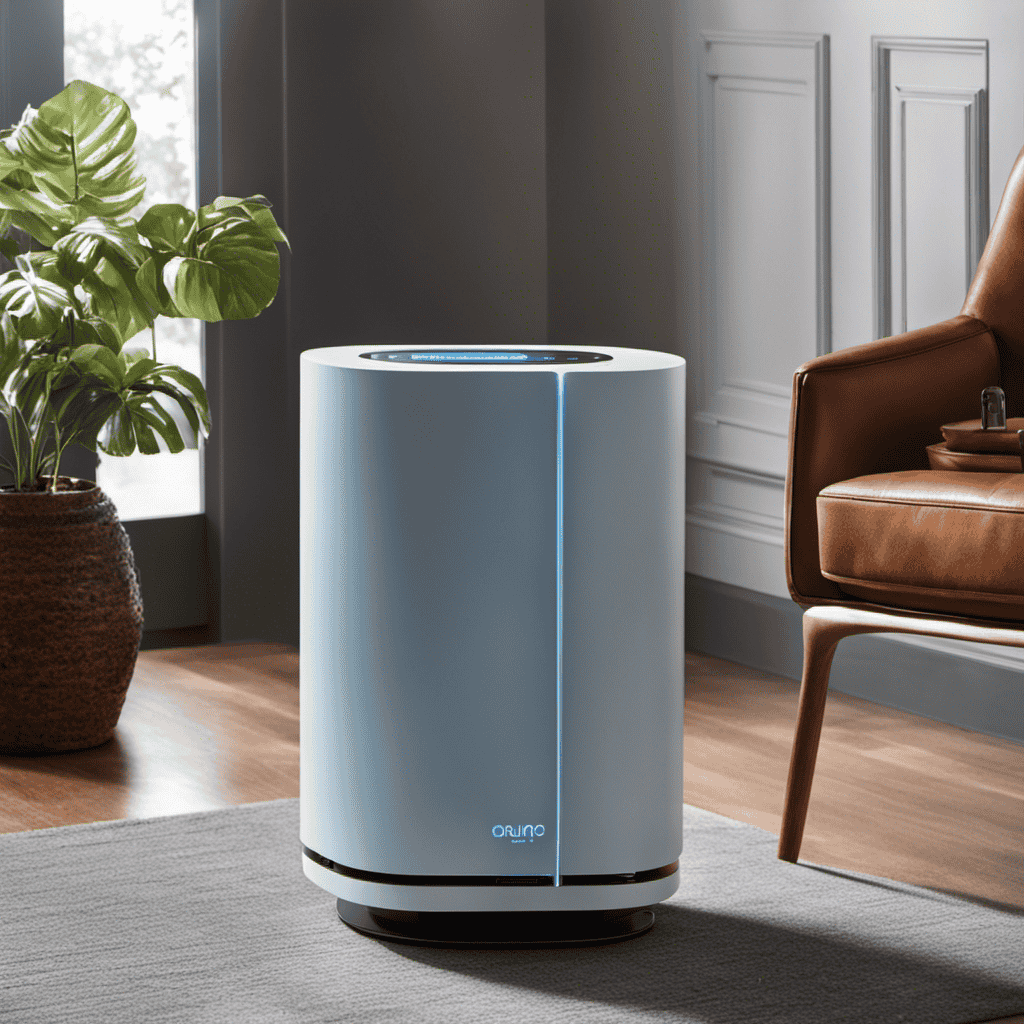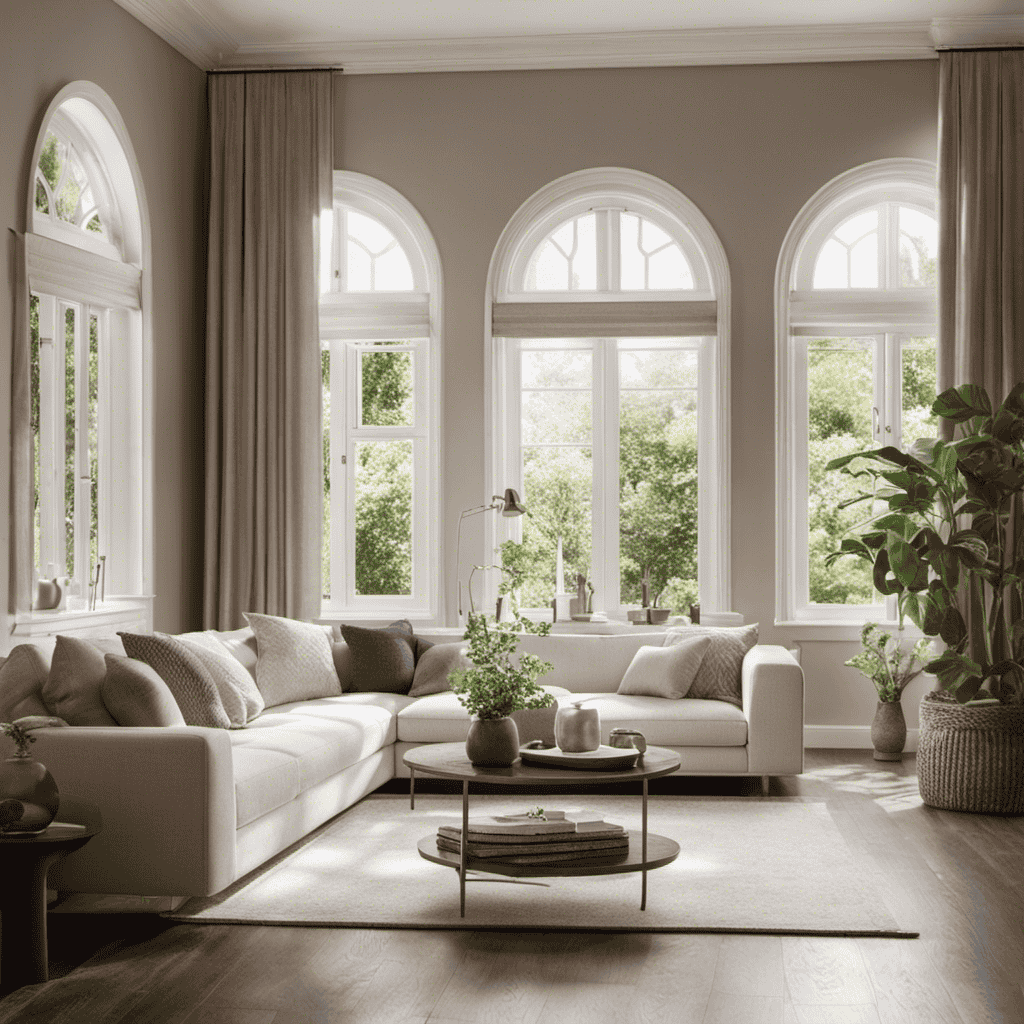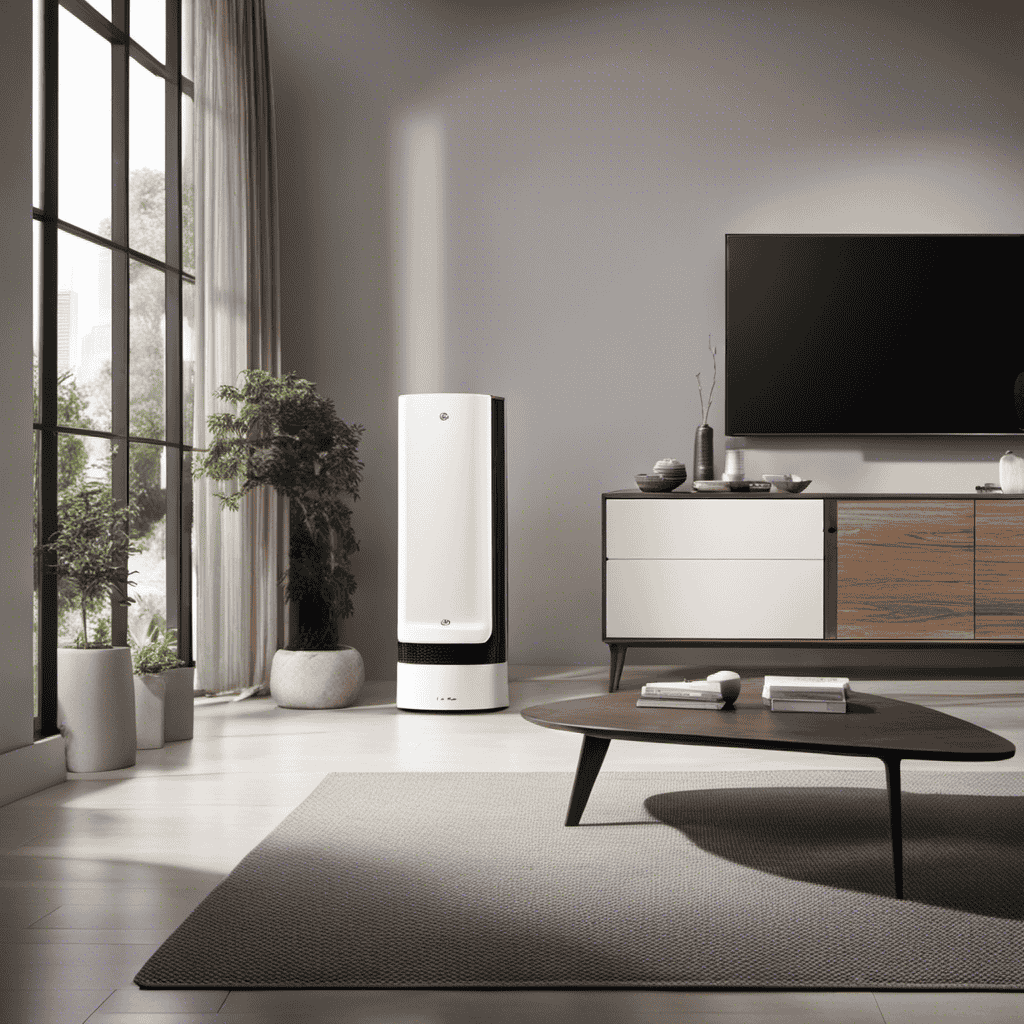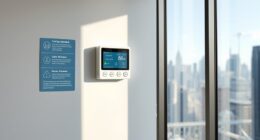I have always been interested in the power consumption of air purifiers as a dedicated user. Knowing how many amps an air purifier uses is important for maximizing energy efficiency and controlling electricity costs.
In this article, we will delve into the relationship between amps and energy efficiency, explore the factors influencing an air purifier’s amp usage, compare different types of purifiers, and provide tips for reducing amp usage.
Get ready to dive deep into the technical world of air purifiers!
Key Takeaways
- The power consumption of air purifiers typically ranges from 0.5-2 amps.
- Amp ratings provide information about the power demand and potential energy usage of the device.
- Energy Star certified air purifiers are designed to be more energy-efficient, resulting in significant energy savings.
- Adjusting fan speed, using timers, and considering energy-saving options can help reduce energy usage and optimize power consumption.
Understanding the Power Consumption of Air Purifiers
Air purifiers typically use around 0.5-2 amps of power. Understanding the power consumption of air purifiers is crucial for efficient usage and preventing electrical issues. To comprehend the power usage of an air purifier, it is essential to consider the wattage of the device.
The wattage of an air purifier indicates the rate at which it consumes electrical energy. It is calculated by multiplying the voltage (in volts) by the current (in amps) drawn by the device. For instance, if an air purifier operates at 120 volts and consumes 1.5 amps, the wattage would be 180 watts (120 volts * 1.5 amps).
By knowing the wattage, one can determine the energy consumption and the associated cost of running the air purifier. Additionally, it helps in understanding the power requirements and compatibility with different electrical systems.
It is important to note that air purifiers may have varying power usage depending on the fan speed setting, additional features, and the size of the unit. Higher fan speeds and additional features may increase the power consumption, resulting in higher energy usage.
Understanding the power usage of air purifiers allows users to make informed decisions about energy efficiency and cost-effectiveness. It enables them to select the appropriate air purifier for their needs and optimize its operation to achieve clean air while minimizing electricity consumption.
The Relationship Between Amps and Energy Efficiency in Air Purifiers
When it comes to air purifiers, understanding the relationship between amps and power consumption is crucial.
Amps, short for amperes, measure the rate at which electric current flows through a device. By examining the amps of an air purifier, we can determine how much power it consumes and make informed decisions about its energy efficiency.
Additionally, amps play a significant role in the performance and cost efficiency of air purifiers, as they directly impact the unit’s ability to filter and circulate air effectively while minimizing energy usage.
Amps and Power Consumption
To determine the amps and power consumption of an air purifier, you can check the label or manual for the information. Understanding amp ratings is crucial when calculating power consumption. Here are some key points to consider:
-
Label or manual: The manufacturer usually provides the amp rating and power consumption details on the label or in the product manual. This information is essential for determining the energy requirements of the air purifier.
-
Amp rating: The amp rating indicates the amount of electrical current the air purifier draws when operating. It helps you understand the power demand and potential energy usage of the device.
-
Power consumption: Power consumption is calculated by multiplying the amp rating by the voltage of the electrical system. This value represents the actual energy consumed by the air purifier over time.
-
Efficiency considerations: Understanding the amp rating and power consumption can help you assess the efficiency of the air purifier. Lower amp ratings and power consumption generally indicate higher energy efficiency.
Amps and Performance
If you want to assess the performance of your air purifier, start by checking the CADR (Clean Air Delivery Rate) for different pollutants. The CADR is a measure of how effectively the air purifier can remove specific pollutants from the air. It is usually measured in cubic feet per minute (CFM) and can give you an idea of how quickly the purifier can clean the air in a given space.
To ensure optimal performance, it is important to choose an air purifier with a CADR that matches the size of the room you want to purify. Additionally, consider energy saving tips such as using the air purifier only when necessary or using it on a lower fan speed setting. These practices can help reduce energy consumption while maintaining clean and healthy air.
Amps and Cost Efficiency
You can save money on your electric bill by choosing an air purifier with lower energy consumption. When considering the cost effectiveness of an air purifier, it is important to take into account its energy savings. Here are four key factors to consider:
-
Energy Star Certification: Look for air purifiers that are Energy Star certified. These models are designed to be more energy-efficient, resulting in significant energy savings over time.
-
Power Consumption: Check the power consumption of the air purifier. Opt for models with lower amp ratings, as they consume less energy and are more cost effective in the long run.
-
Fan Speed Settings: Choose an air purifier with adjustable fan speed settings. Running the purifier on a lower fan speed can reduce energy usage while still maintaining optimal air filtration.
-
Timer Function: Consider air purifiers with built-in timer functions. This allows you to set specific operating hours, saving energy when the purifier is not needed.
Factors That Influence the Amps Used by an Air Purifier
Factors like the size and type of air purifier can influence the amps it uses. When it comes to energy consumption, there are several factors to consider.
Firstly, the size of the purifier plays a key role. Generally, larger air purifiers tend to consume more energy compared to smaller ones. This is because they have larger motors and fans to circulate air effectively.
Additionally, the type of air purifier also impacts energy consumption. Different technologies, such as HEPA filters or activated carbon filters, require varying levels of power to operate. HEPA filters, for example, are highly effective in removing small particles from the air but may consume more energy due to their dense filtration material. On the other hand, activated carbon filters are efficient at removing odors and chemicals but may not require as much power.
It’s important to note that while energy consumption is a crucial factor to consider, the impact on air quality should also be taken into account. Choosing an air purifier that balances energy efficiency with effective filtration can lead to optimal results in terms of both energy consumption and air quality improvement.
Comparing the Amps of Different Types of Air Purifiers
When it comes to comparing the amps of different types of air purifiers, there are a few key factors to consider.
One important aspect is power consumption variations, as different types of air purifiers may have varying energy needs.
Additionally, energy efficiency rankings are crucial to assess the overall efficiency of an air purifier in terms of power consumption.
Lastly, understanding the correlation between amps and performance is vital to determine the optimal balance between energy usage and the effectiveness of an air purifier.
Power Consumption Variations
To understand power consumption variations, it’s important to consider the different settings and features of an air purifier. The power consumption analysis of an air purifier depends on several factors, including the fan speed, filtration technology, and additional features.
Here are some key points to consider:
-
Fan Speed: Higher fan speeds typically consume more power due to increased air circulation and filtration.
-
Filtration Technology: Different air purifiers use various filtration technologies, such as HEPA filters or activated carbon filters, which may affect power consumption.
-
Additional Features: Some air purifiers offer additional features like timers, indicators, or sleep modes, which can optimize power consumption based on user preferences.
-
Energy Saving Options: Many air purifiers now come with energy-saving options, such as auto mode or eco mode, which adjust the fan speed and power consumption based on air quality.
Understanding these variations can help users choose the most efficient air purifier for their needs while minimizing power consumption and maximizing energy savings.
Energy Efficiency Rankings
The energy efficiency rankings of air purifiers can help consumers make informed decisions about their power consumption. When it comes to choosing an air purifier, it is important to consider its energy efficiency rating.
Air purifiers with higher energy efficiency rankings consume less power, which not only reduces energy consumption but also helps save on electricity bills.
Additionally, there are several tips for reducing energy consumption when using an air purifier. One tip is to use the air purifier only when necessary, such as during peak pollution hours or when there are specific allergens in the air.
Another tip is to clean or replace the filters regularly to ensure optimal performance and energy efficiency.
Amps and Performance Correlation
Using an air purifier with higher energy efficiency rankings can help consumers save on electricity bills and reduce power consumption. However, it’s important to consider the correlation between amps and the performance of the air purifier.
Here are some key factors to understand:
-
Amps and Air Quality: The higher the amp rating of an air purifier, the more powerful it is in removing pollutants from the air. This means that air purifiers with higher amp ratings are generally more effective in improving indoor air quality.
-
Amps and Filter Lifespan: Air purifiers with higher amp ratings often have larger and more efficient filters. These filters can capture more particles and contaminants, leading to a longer lifespan before needing replacement.
-
Energy Efficiency: While air purifiers with higher amp ratings may be more effective, they also consume more electricity. It’s crucial to strike a balance between performance and energy efficiency to avoid excessive power consumption.
-
Noise Level: Air purifiers with higher amp ratings may produce more noise due to the powerful motor required to deliver better performance. Consider the noise level tolerance when selecting an air purifier.
Understanding the relationship between amps and air purifier performance is essential in making an informed decision. Now, let’s explore how to determine the amps required for your air purifier.
How to Determine the Amps Required for Your Air Purifier
First, you’ll need to gather the necessary information to determine the amps required for your air purifier. To do this, you’ll need to know the power requirements of your air purifier, as well as the voltage it operates on. The power requirements can usually be found in the user manual or on the product label.
Once you have the power requirements, you can calculate the energy usage of your air purifier. To do this, you’ll need to multiply the power requirements by the operating voltage. For example, if your air purifier requires 100 watts and operates on 120 volts, you would divide 100 by 120 to get 0.83 amps.
It’s important to note that the power requirements of your air purifier may vary depending on the settings and features you are using. For example, if your air purifier has a high-speed mode or an ionizer, it may require more power.
Tips for Reducing the Amps Used by Your Air Purifier
Now that we know how to determine the amps required for an air purifier, let’s explore some tips for reducing the amps used by this appliance. By implementing these strategies, we can effectively reduce energy consumption and minimize the impact on our electricity bills.
Here are some practical tips for reducing the amps used by your air purifier:
-
Opt for energy-efficient models: Look for air purifiers that have an ENERGY STAR certification. These models are designed to consume less energy while maintaining optimal performance.
-
Adjust the fan speed: Most air purifiers have adjustable fan speeds. By reducing the fan speed to the lowest necessary level, you can significantly reduce energy consumption.
-
Use a timer: Set a timer on your air purifier to run for specific periods of time. This way, it will only operate when needed, helping to minimize unnecessary energy usage.
-
Keep the air purifier clean: Regularly clean and maintain your air purifier to ensure optimal performance. A dirty filter or clogged vents can cause the appliance to work harder, leading to increased energy consumption.
The Impact of Amps on Your Electricity Bill From Using an Air Purifier
To reduce the impact on your electricity bill, consider the energy consumption of your air purifier. Understanding how many amps an air purifier uses can help you make an informed decision about its electricity cost. The energy consumption of an air purifier is measured in amps, which refers to the amount of electric current flowing through the device. The higher the amps, the more energy the air purifier consumes, resulting in higher electricity costs.
To give you a better idea of the energy consumption of different air purifiers, here is a table showcasing the average amps used by common air purifier models:
| Air Purifier Model | Average Amps |
|---|---|
| Model A | 1.5 Amps |
| Model B | 2 Amps |
| Model C | 0.8 Amps |
By referring to this table, you can compare the energy consumption of different air purifiers and choose one that suits your needs while keeping electricity costs in check. Additionally, it’s important to note that the amps used by an air purifier may vary depending on its settings and usage duration.
Being aware of the energy consumption of your air purifier allows you to make a more conscious decision about its usage, helping you reduce your electricity costs and minimize your environmental impact.
Are Amps and Watts Usage Linked in Air Purifiers?
Yes, amps and watts used by air purifier are linked. Amps measure the electrical current while watts represent the overall power consumption. Ideally, a higher wattage in an air purifier will result in higher electricity consumption, meaning higher amps will be needed to power it.
Frequently Asked Questions
Can I Use an Air Purifier With a Power Strip or Extension Cord?
Yes, I can use an air purifier with a power strip or extension cord. However, it is important to be cautious when using power strips with other household appliances. Overloading the power strip can lead to overheating and fire hazards.
Additionally, using extension cords with high powered devices can also pose potential risks. It is recommended to consult the manufacturer’s guidelines and ensure that the power strip or extension cord can handle the amp requirements of the air purifier to avoid any safety issues.
Are Air Purifiers Safe to Use Overnight or When I’m Not at Home?
When it comes to air purifiers, safety is a top concern, especially when using them overnight or when you’re not at home. I can assure you that air purifiers are designed to operate safely in these situations.
However, it’s important to follow proper maintenance guidelines to ensure optimal performance. Regularly cleaning or replacing filters and keeping the unit free from dust and debris are essential.
The benefits of using an air purifier include improved air quality, reduced allergens, and a healthier living environment.
Can I Use an Air Purifier in a Room With High Humidity, Such as a Bathroom?
I can use an air purifier in a room with high humidity, such as a bathroom. However, it’s important to note that the moisture in the air can affect the performance and longevity of the purifier.
To maintain its effectiveness, regular maintenance is necessary, including cleaning or replacing filters.
Using an air purifier in high humidity areas can provide benefits like reducing mold and mildew growth, eliminating odors, and improving air quality.
Can Air Purifiers Be Harmful to Pets or Children?
Air purifiers can be effective in removing pollutants and improving air quality. However, they can also have potential side effects on pets and children. Some air purifiers emit ozone, which can be harmful to both.
It’s important to choose an air purifier that doesn’t produce ozone and to follow the manufacturer’s instructions for safe use. Regular maintenance and filter replacement are also essential for optimal performance.
Overall, air purifiers can be beneficial, but precautions should be taken to ensure their safety.
Do Air Purifiers Make Noise While Operating?
Air purifiers can be quite noisy when operating, which can be a nuisance to some people. The noise level depends on the model and settings of the air purifier.
However, there are ways to reduce the noise generated by an air purifier. Some tips include placing the purifier on a stable surface, using a noise-reducing pad or stand, or adjusting the fan speed.
Conclusion
In conclusion, understanding the power consumption of air purifiers is crucial for optimizing their energy efficiency. By considering the relationship between amps and energy usage, as well as various factors that influence amps, you can make informed decisions about the type of air purifier that suits your needs.
Interestingly, according to a study by the Energy Star program, air purifiers typically consume around 50-200 watts of power, which is equivalent to using a standard light bulb. Being mindful of the amps used by your air purifier can help you manage your electricity bill effectively.
